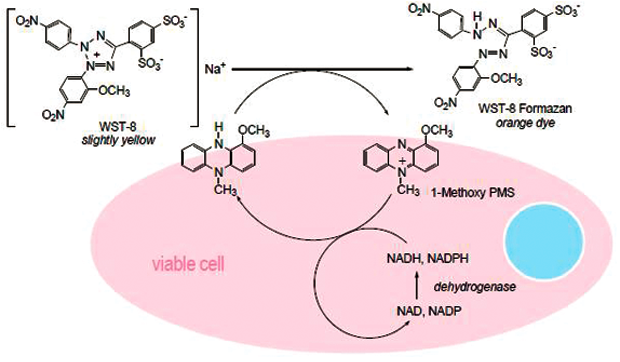Cell Counting Kit-8 (CCK-8) allows sensitive colorimetric assays for the determination of cell viability in cell proliferation and cytotoxicity assays. The highly water-soluble tetrazolium salt, WST-8, is reduced by dehydrogenase activities in cells to give a yellow-color formazan dye, which is soluble in the tissue culture media. The amount of the formazan dye, generated by the activities of dehydrogenases in cells, is directly proportional to the number of living cells. The detection sensitivity of CCK-8 is higher than the other tetrazolium salts such as MTT, XTT, MTS or WST-1.
|
|

Figure 1. Comparison of the sensitivity using tetrazolium dye
| Protocol (PDF): | A014 |
| MSDS (PDF): | MSDS-A014 |
| COA (PDF): | COA-A014 |
Q&A
For adhesive cells, at least 1,000 cells are necessary per well (100 μl medium) when using a standard 96-well plate.
For leukocytes, at least 2,500 cells are necessary per well (100 μl medium) because of low sensitivity.
The recommended maximum number of cells per well for the 96-well plate is 25,000. If 24-well or 6-well plates are used for this assay, please calculate the number of cells per well accordingly, and adjust the volume of the CCK-8 solution in each well to 10% of the total volume.
Can this kit be used with a 384-well plate?
Yes, you can use this kit for a 384-well plate. Add CCK-8 solution with 1/10 volume of the culture medium in a well. If the volume of CCK-8 to be added is too small, dilute CCK-8 in half with the medium and add 1/5 of the volume of culture medium in a well.
Can this kit be used with a 24-well plate?
Yes. Add CCK-8 solution with 1/10 volume of the culture medium in a well.
Does CCK-8 stain viable cells?
No, it does not stain viable cells because a water-soluble tetrazolium salt (WST-8) is used for the CCK-8 solution. The electron mediator, 1-Methoxy PMS, receives electrons from viable cells and transfers the electrons to WST-8 in the culture medium. Since its formazan dye is also highly water soluble, CCK-8 cannot be utilized for cell staining.
Does phenol red affect the assay?
No. The absorption value of phenol red in culture medium can be removed by subtracting the absorption value of a blank solution from the absorption value of each well. Therefore, culture medium containing phenol red can be used for the CCK-8 assay.
Is there a correlation between CCK-8 and the Thymidine incorporation assay?
Yes. However, please note that since CCK-8 uses a different assay mechanism from that of the Thymidine assay, so the results may differ.
Is CCK-8 toxic to cells?
Since the toxicity of CCK-8 is so low, the same cells can be used for other cell proliferation assays such as the crystal violet assay, neutral red assay or DNA fluorometric assay after the CCK-8 assay is completed.
How stable is CCK-8?
CCK-8 is stable over 6 months at room temperature and one year at 0-5 oC with protection from light. For longer storage, we recommend storing the solution at -20 oC ; CCK-8 is stable over 2 years at -20 oC.
I do not have a 450 nm filter. What other filters can I use?
You can use filters with an absorbance between 450 nm and 490 nm.
Cited Reference:
An in vitro Study on Anticancer Activity of Noscapine
Funda Karabag Çoban, Ibrahim Bulduk, Izzet Islam and Hande Aytug
Journal of Pharmaceutical Research International, 2021, 33(11): 72-80. https://doi.org/10.9734/jpri/2021/v33i1131246
Investigation of The Apoptotic and Antiproliferative Effects of Boron on CCL-233 Human Colon Cancer Cells
Özyarım SC, Karabag Çoban F.
Cell J. 2021 Sep;23(4):429-434. doi: 10.22074/cellj.2021.7259
Xiaochaihu Decoction reduces hepatic steatosis and improves D-GalN/LPS-induced liver injury in hybrid grouper (Epinephelus lanceolatus♂×Epinephelus fuscoguttatus♀).
Zou, C., Xu, M., Chen, L., Liu, Q., Zhou, Y., Sun, Z., … Wang, A.
Fish & Shellfish Immunology. 2019, 91:293-305. doi:10.1016/j.fsi.2019.05.025
Determination of Antioxidant Activity of Leaves and Flowers of Faba bean
Erten Akbel, Funda Karabag & Ibrahim Bulduk
International Journal of Innovative Approaches in Agricultural Research 2022, Vol. 6 (3), 279-288. https://doi.org/10.29329/ijiaar.2022.475.11
- Cell-ID™ CFSE Cell Proliferation Kit
- Cell-ID™ Violet Cell Proliferation Kit
- iClick™ EdU Andy Fluor™ 488 Imaging Kit
- iClick™ EdU Andy Fluor™ 555 Imaging Kit
- iClick™ EdU Andy Fluor™ 594 Imaging Kit
- iClick™ EdU Andy Fluor™ 647 Imaging Kit
- iClick™ EdU Andy Fluor™ 488 Flow Cytometry Assay Kit
- iClick™ EdU Andy Fluor™ 647 Flow Cytometry Assay Kit
- iClick™ EU Andy Fluor™ 488 Imaging Kit
- iClick™ EU Andy Fluor™ 594 Imaging Kit
- CCK-8
- Cell-Quant™ MTT Cell Proliferation Assay Kit
- Cell-Quant™ AlamarBlue Cell Viability Reagent


